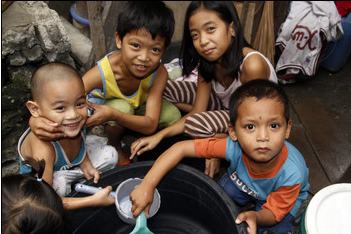Site will be
unavailable for maintenance from June. 4, 11:30 p.m., to June 5, 12:30 a.m. ET. Thank you for your
patience!
Improving Sanitation in the Philippines
Posted on 06/06/2013

Clean water and good sanitation are major needs in the Philippines.
The Philippines has a population of more than 95 million people, making it one of the most populous countries in Asia. Approximately one-third of the country's population lives in poverty, and for many families, inadequate sanitation is a serious problem. Without access to improved sanitation, children and their families are at much greater risk of contracting waterborne diseases, which kill many people every year.
Lives at Risk
According to a 2005 report published by the United Nations' Department of Economic and Social Affairs, around 25 Filipinos die every day from diarrhea caused by poor water sanitation. In poverty-stricken communities, outbreaks of waterborne diseases are common, and for many families, seeking even basic health care can be prohibitively expensive. Although access to improved sanitation facilities in urban areas has improved substantially in recent years, families in rural parts of the Philippines still lack adequate sanitation.
A recent study published by the Water and Sanitation Program revealed that not only does the current situation in the Philippines demand urgent attention, the country's annual population growth of 2 percent is likely to place a greater burden on already limited resources. Approximately 2 million additional Filipinos will require access to adequate sanitation facilities every year.
Taking Action
Although the situation is serious, progress is occurring. The World Bank reports that in communities where water-treatment facilities have been introduced, many local residents have become involved in riverside cleanup operations. In some parts of the country, combined sewer and drainage systems have resulted in improved sanitary conditions, and community leaders have been are actively engaged in operations of decentralized sewage and waste disposal services.
Some schools in the Philippines also lack adequate water systems, which can interfere with children's learning and educational development. For this reason, ChildFund worked with Nabilid Elementary School to construct a new water system at the school to provide clean water to pupils and staff.
"Completion of the water supply systems in these five areas alone will benefit a total student population of 20,000 boys and girls," says Marlene, a staff member with ChildFund Philippines.
This project is one example of how we are making a difference to children in the Philippines, but to continue our work, we need your help. Please consider making a donation to our Children's Greatest Needs fund today, a fund that helps provide clean water and sanitation facilities to many families in need.
Loading...

